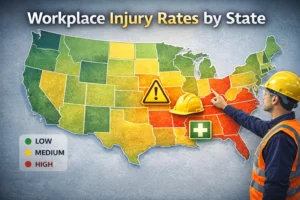As spring turns to summer and outdoor activities pick up, May offers the perfect opportunity to reinforce safety awareness in the workplace and beyond. This month holds several national safety observances and industry-specific campaigns, making it an ideal time to prioritize discussions around electrical hazards, mental health, construction safety, and fall prevention.


Whether you’re an employer planning toolbox talks or a safety professional designing training modules, May is packed with themes that promote a proactive safety culture. Let’s explore the key safety topics and initiatives you can incorporate into your safety programs this May 2025.
1. National Electrical Safety Month
National Electrical Safety Month, spearheaded by the Electrical Safety Foundation International (ESFI), shines a spotlight on the importance of electrical hazard awareness and prevention both at home and in the workplace. Each year, thousands of preventable electrical injuries and fires occur, often due to outdated wiring, lack of proper training, or unsafe work practices.
Workplace Electrical Safety Focus:

- Qualified Personnel: Emphasize that only trained and qualified individuals should perform electrical work.
- Lockout/Tagout (LOTO): Reinforce the procedures to de-energize electrical systems before maintenance.
- Inspection Protocols: Encourage regular inspections of tools, extension cords, and equipment for frayed wires or damage.
- Personal Protective Equipment (PPE): Remind workers to use insulated gloves, voltage-rated tools, and arc-flash gear as appropriate.
Encourage employees to report potential hazards and provide refresher training on electrical safety basics, including how to identify warning signs and respond to electrical incidents.
2. Mental Health Awareness Month
Mental health is just as critical as physical safety, especially in high-stress and high-risk environments. Mental Health Awareness Month, recognized every May, encourages open dialogue, education, and support for mental well-being.
Mental Health in the Workplace:

- Stress Management: Discuss practical techniques like mindfulness, deep breathing, and time management.
- Breaking the Stigma: Create a culture where it’s okay to talk about mental health without fear of judgment.
- Access to Resources: Share contact information for Employee Assistance Programs (EAPs), hotlines, or local counselors.
- Training Supervisors: Equip leaders with tools to recognize signs of burnout, depression, or substance abuse.
By integrating mental health into your safety talks, you promote a holistic approach to worker wellness and help build a resilient workforce.
3. Construction Safety Week (May 5–9, 2025)
Construction Safety Week is a vital industry-led initiative that takes place in the first full week of May. The theme for 2025 is “Value Every Voice,” emphasizing the importance of communication, collaboration, and commitment in keeping construction workers safe.
Key Focus Areas:

- Daily Toolbox Talks: Cover topics like fall protection, trench safety, ladder use, and PPE.
- Leadership Engagement: Encourage managers and supervisors to participate actively in safety discussions.
- Interactive Demos: Host equipment safety demonstrations or hands-on training stations.
- Recognition and Incentives: Acknowledge employees who consistently follow safety practices.
Use this week to spotlight safety champions on your team and to renew your organization’s commitment to continuous improvement.
4. National Safety Stand-Down to Prevent Falls in Construction (May 5–9, 2025)
Coinciding with Construction Safety Week is the National Safety Stand-Down, a nationwide event led by OSHA to prevent falls, the leading cause of fatalities in the construction industry.
Stand-Down Best Practices:

- Pause the Work: Set aside time during the workday to talk directly about fall prevention.
- Focus Topics: Guardrails, harnesses, anchorage points, scaffolding, and roof safety.
- Demonstrations: Show proper donning and inspection of fall arrest systems.
- Employee Feedback: Allow workers to voice concerns or share experiences with fall hazards.
Employers can receive a certificate of participation from OSHA, which also serves as a symbol of their dedication to protecting their workforce.
5. Heat Stress Awareness and Prevention
As temperatures begin to rise in many parts of the country, it’s essential to revisit heat-related safety. Whether your team works outdoors or in hot indoor environments, the risk of heat exhaustion and heatstroke grows in May.
Prevention Tips:

- Hydration Stations: Ensure workers have easy access to cool drinking water.
- Acclimatization: Gradually increase exposure for new or returning workers.
- Rest Breaks: Encourage regular shaded or air-conditioned breaks.
- Heat Illness Symptoms: Train employees to recognize and respond to symptoms like dizziness, confusion, and nausea.
Highlight the importance of looking out for one another and not pushing through when signs of heat stress appear.
6. Emergency Preparedness and Evacuation Plans
With unpredictable weather patterns and the onset of storm season in some areas, May is a good time to review your emergency response plans.
Key Preparedness Elements:

- Evacuation Routes: Post and communicate routes and muster points.
- First Aid and CPR: Offer or refresh training for designated first responders.
- Emergency Drills: Conduct a fire or severe weather drill.
- Communication Plans: Ensure contact information is up-to-date, and roles are assigned.
Encourage employees to prepare personal emergency kits and discuss family readiness plans at home.
7. Slips, Trips, and Falls
While falls from heights are a major concern in construction, slips and trips on the same level are common across all industries. According to the National Safety Council, these incidents are among the leading causes of workplace injuries.
Prevention Strategies:

- Housekeeping: Keep walkways clear of clutter, cords, and spills.
- Lighting: Ensure adequate lighting in all work and walking areas.
- Signage: Use “Wet Floor” signs and other hazard warnings effectively.
- Footwear: Promote the use of anti-slip shoes or boots.
Reinforce that preventing these types of accidents takes vigilance from everyone on the team.
8. Seasonal Driving and Distracted Driving Awareness
May also marks a period of increased travel due to holidays and warmer weather. As such, it’s a great time to highlight safe driving practices, especially for employees who operate fleet vehicles or commute long distances.
Topics to Address:

- Cell Phone Policies: Reinforce no-texting policies and hands-free device usage.
- Vehicle Inspections: Check tires, brakes, lights, and fluid levels regularly.
- Fatigue Management: Remind drivers to rest adequately before long trips.
- Weather Awareness: Review safe driving in rain and reduced visibility conditions.
Encouraging employees to stay focused and rested behind the wheel can reduce accidents both on and off the clock.
In Conclusion
May provides a wealth of opportunities to engage your workforce on a wide range of safety and wellness topics. From electrical safety and mental health to fall prevention and emergency planning, each initiative supports a broader culture of awareness and accountability.
By aligning your workplace safety strategy with these national observances, you not only adhere with regulations but also demonstrate genuine care for your employees’ physical and mental well-being.
Let’s make May 2025 a month of strong voices, safe choices, and lasting impact.




